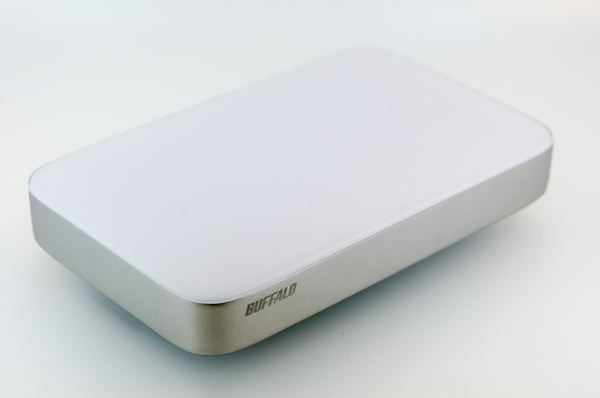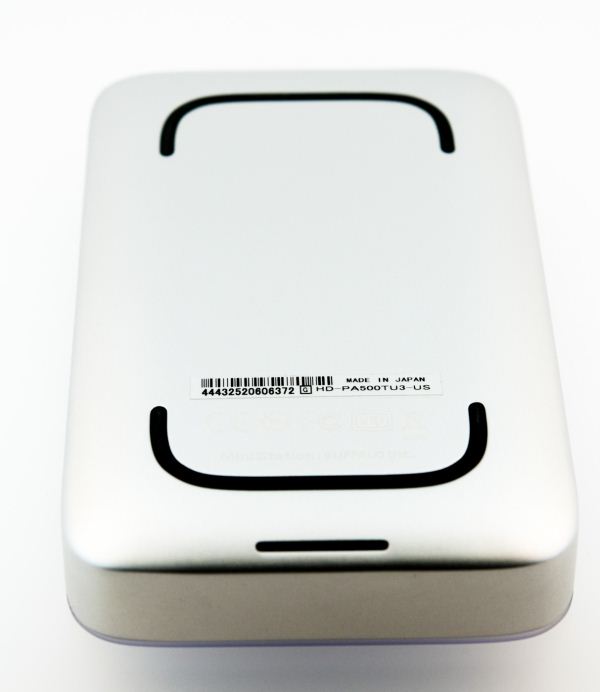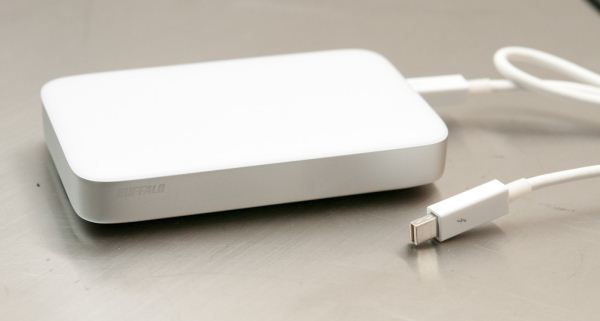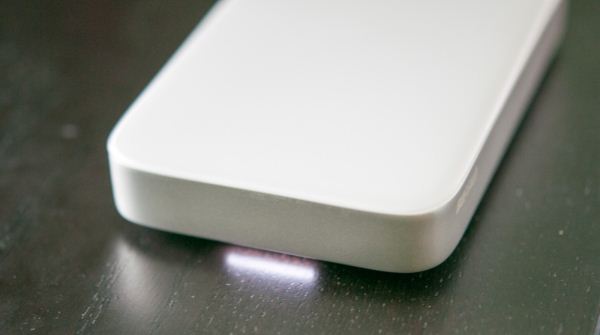Buffalo MiniStation Thunderbolt Review - An External with USB 3.0 and Thunderbolt
by Brian Klug on August 1, 2012 4:04 PM EST- Posted in
- Storage
- SSDs
- USB 3.0
- Thunderbolt
- Buffalo
Back when Thunderbolt (then Intel Lightpeak) was optical, I was actively involved in covering the interface, partly out of professional curiosity due to my optical background, partly because I sincerely believe optical interfaces are an inevitable part of the future. When Lightpeak became Thunderbolt and lost the optical layer, it fell under Anand’s beat and the Mac umbrella. I acquired a MacBook Pro with Thunderbolt somewhere around the same time, but never acquired any Thunderbolt peripherals or drives. Since then, Thunderbolt has slowly but surely gained traction with more and more peripherals and host devices. Initial adoption was glacial in part because most of the earliest Thunderbolt peripherals were really aimed at the very high end market with big RAID or JBOD stations, and partly due to what boiled down to Thunderbolt being Apple-only until just recently.
There’s an interesting story as to exactly why most of the initial Thunderbolt peripherals were aimed at such a high-end market, and some of it was purely because of both the TDP, size, and engineering constraints involved with the first generation Thunderbolt controllers. The other half of the equation is that selling external storage isn’t always the most valuable prospect, as shoppers expect commodity pricing and generally know the cost of the drive inside. Thankfully, second generation Thunderbolt controllers with smaller size, TDP, and lower cost are now the norm, and at the same time Apple has unleashed more Macs with the interface of note, meaning that there’s a bigger captive market of potentially interested shoppers.
So when Buffalo dropped us a line about an upcoming 2.5" form factor portable hard drive with both USB 3.0 and Thunderbolt interfaces, I couldn’t resist the temptation and jumped at the opportunity to review it. When it comes to single drive external Thunderbolt storage, the only real options at this point are either the Seagate GoFlex, or the new Buffalo MiniStation Thunderbolt.
The Buffalo MiniStation comes in two flavors, differentiated only in storage size. There’s a 1 TB version which runs $229.99 named the HD-PA1.0TU3, and a 500 GB version named the HD-PA500TU3 and priced at $199.99. The only difference is what drive you get inside; both include Thunderbolt and USB 3.0. Buffalo has also opted to include both the USB 3.0 and Thunderbolt cables with both MiniStations. Prior drives required the separate purchase of a Thunderbolt cable, which costs around $50. Since there are now multiple cable suppliers (whether this means the active controller in the cable, or companies cabling the system remains unknown to me), pricing has started creeping down and Buffalo was able to include both a 19.7 inch Thunderbolt cable and USB 3.0 cable.
| Buffalo MiniStation Thunderbolt | |||||
| HD-PA500TU3 | HD-PA1.0TU3 | ||||
| Storage | 500 GB HDD | 1 TB HDD | |||
| Interface | miniUSB 3.0 (2.0 legacy), Thunderbolt (no pass through), Cables Included | ||||
| Formatting | Mac (HFS+) | ||||
| Size, Mass | 3.17 x 5.12 x 0.91 (inches), 9.28 oz | ||||
| Pricing | $199.99 (newegg) | $229.99 (newegg) | |||
Since Thunderbolt is still predominantly an Apple interface (7-series boards and IVB Ultrabooks notwithstanding), the industrial design of the Buffalo MiniStation is decidedly Apple inspired. The drive is made of two main parts, a single piece aluminum can in which the drive sits, and a plastic top which snaps inside this assembly.
There’s a series of white status LEDs which shine through a diffuse rectangular chicklet cutout on the bottom front lip, which reflects up off of a surface. The indicator light breathes like an Apple power indicator when there’s activity, and stays solid when plugged in. It’s a nice take on an external hard disk status LED that I haven’t seen done before.
On the underside are two small rubber feet which actually aren’t part of the aluminum base but make contact with the drive caddy inside. Regulatory markings are laser etched near the front rubber foot. At the back of course are the Thunderbolt and USB 3.0 ports, on opposite sides of the drive.
Construction of the MiniStation is subjectively great. There’s not much flex if you squeeze the aluminum side against the plastic lip, and it feels like a solid brick of aluminum in the hand. I’ve regularly transferred videos shot on my DSLR onto the MiniStation, then tossed the drive into the main pocket of my backpack. It isn’t a super rugged design, but definitely will get the job done.





















61 Comments
View All Comments
VKone - Friday, August 3, 2012 - link
Hi there,I assume it´s possible to boot from this TB drive to OS X.
How about booting to Win7 or Win 8. As far as I recollect, this has not been possible in the past with Firewire Drives. Does it work with TB now?
Thanks, CXC
munsie - Monday, August 13, 2012 - link
It would depend on if the BIOS supported it or not. Since a drive connected up via TB looks like another SATA drive connected to a PCIe bridge, the OS shouldn't care. But if the BIOS doesn't even look for bootable drives on SATA ports that aren't on the motherboard, it won't matter.I think, but haven't verified myself, that any Apple machine with TB can boot Windows over TB.
serons - Friday, August 3, 2012 - link
Why are the controller chips in the cable and not in the devices that it connects?repoman27 - Friday, August 3, 2012 - link
The controllers are in the devices, not the cables.The cables are active, however, and have several small chips in each connector which help compensate for various signaling issues. This allows the use of thinner, more flexible, stranded conductors and can lower overall power consumption. Active cables are fairly common at signaling rates of 10.3125 GBaud.
Everyone seems to think Thunderbolt cables are expensive because they are active, but even passive twinax cables that can handle 2x 10 Gbps channels are pretty pricey.
End User - Friday, August 3, 2012 - link
I was tickled pink when I popped a M4 into a $10 OKGEAR USB 3.0 case. Amazing how cheap things have become. That OKGEAR case certainly makes the MiniStation look a tad pricey but price is not the only factor I go by.I bought the 1TB as soon as I finished the review. My 11" MBA has just 2 USB 3.0 ports so it will be nice to be able to connect a third drive. I can also connect it to the Thunderbolt port on my P8Z77-V PREMIUM.
AnTech - Sunday, August 5, 2012 - link
"Thunderbolt is in practice, which is a one-piece solution that’s powered entirely over either USB2.0/3.0 or Thunderbolt."What???
AnTech - Sunday, August 5, 2012 - link
Mechanism inside? RPM? Sustained (read true) transfer rates (read & write)?Please, bring 2 x Thunderbolt + USB 3 ports for both 750 MB 2.5-inch mobile and 4 TB 3.5-inch desktop drives.
sarangiman - Friday, October 5, 2012 - link
Has anyone tested to see if the Buffalo Ministation works reliably over Thunderbolt (or USB) with a larger capacity SSD, e.g. a 512GB (Samsung 830) or a 480GB (Intel 520) SSD?There was some talk that the power requirement of larger drives would cause disconnections over Thunderbolt in such enclosures, e.g. using the Seagate Portable Thunderbolt adapter.
Thanks in advance!
VKone - Monday, December 10, 2012 - link
I´d also like to know. Any news on that?klutzak5 - Thursday, February 21, 2013 - link
Well, I can seemingly answer this question. I have tried 2 separate Crucial M4 512GB SSDs. and they have both crapped out spectacularly.They initially format and work for a very short period of time. After which, the drives begin to disconnect after around 3 to 4 GB of sustained transfer. These disconnects happen reliably for a while and then the drive refuses to mount.
Attempting to re-initialize the drives will fail with a 'cannot write to last block' error in Mountain Lion. The drives are, for all intents and purposes; hosed.
I thought the first time this happened I had a faulty SSD. Then it happened with the next drive.
So I would say, based on my experience, that you should stay away from 512 GB SSDs, unless you want to run the risk of a $350 to $400 mistake.